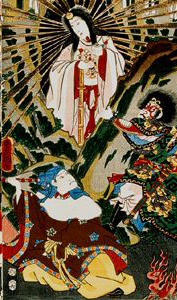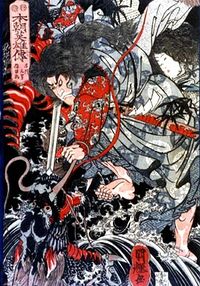Kojiki
| Shinto | |
|---|---|
This article is part of a series on Shinto |
|
|
|
|
| Kami · Ritual purity · Polytheism · Animism · Japanese festivals · Mythology · Shinto shrines | |
|
|
|
| Amaterasu Omikami · Sarutahiko Okami · Ame-no-Uzume-no-Mikoto · Inari Okami · Izanagi-no-Mikoto · Izanami-no-Mikoto · Susanoo-no-Mikoto · Tsukuyomi-no-Mikoto | |
|
|
|
| Kojiki · Nihon Shoki · Fudoki · Rikkokushi · Shoku Nihongi · Jinnō Shōtōki · Kujiki | |
|
|
|
| Japan · Religion in Japan · Glossary of Shinto · List of Shinto divinities · List of Shinto shrines · Sacred objects · Japanese Buddhism · Mythical creatures | |
|
Shinto Portal |
Kojiki (古事記, "Record of Ancient Matters") is the oldest extant chronicle in Japan, dating from the early 8th century and composed by Ō no Yasumaro by Imperial request. The Kojiki is a collection of myths concerning the origin of the islands of Japan, and the Kami. Along with the Nihon Shoki, the myths contained in the Kojiki are part of the inspiration behind Shinto practices and myths, including the misogi purification ritual.[1]
Contents |
Structure
The Kojiki contains various songs/poems. While the historical records and myths are written in a form of Chinese with a heavy admixture of Japanese elements, the songs are written with Chinese characters used to convey sounds only. This special use of Chinese characters is called Man'yōgana, a knowledge of which is critical to understanding these songs. These songs are in the dialect of the Yamato area from about 7th century to 8th century AD, a language called Jōdai Nihongo (lit. "upper age Japanese"). In English, this is most commonly called Old Japanese.
The Kojiki is divided into three parts: Kamitsumaki (lit. "upper roll"), Nakatsumaki (lit. "middle roll") and Shimotsumaki (lit. "lower roll").
The "Kamitsumaki" includes the preface and is focused on the deities of creation and the births of various deities.
The "Nakatsumaki" begins with the story of Emperor Jimmu, the first Emperor, and his conquest of Japan, and ends with the 15th Emperor, Emperor Ōjin. Many of the stories it contains are mythological, and the allegedly historical information in them is highly suspect. For unknown reasons, the 2nd to 9th Emperors are listed but their achievements are largely missing. Recent studies support the view that these emperors were invented to push Jimmu's reign further back to the year 660 BC.
The "Shimotsumaki" covers the 16th to 33rd Emperors and, unlike previous volumes, has very limited references to the interactions with deities which are so prominent in the first and second volumes. Information on the 24th to 33rd Emperors are largely missing as well.
In History
In the Edo period, Motoori Norinaga studied the Kojiki intensively, the results of which were published in his Kojiki-den ("Kojiki commentary"). It was first claimed in the Edo period that the Kojiki may have been forged later than it was supposed to have been written.
The first and best-known English translation of the Kojiki was made by the renowned Japanologist Basil Hall Chamberlain. More recently, a translation by Donald L. Philippi was published by University of Tokyo Press in June 1977 (ISBN 0-86008-320-9).
Manuscripts
There are two major branches of Kojiki manuscripts: Ise and Urabe. The extant Urabe branch consists of 36 existing manuscripts all based on the 1522 copies by Urabe Kanenaga. The Ise branch may be subdivided into the Shinpukuji (真福寺本) manuscript of 1371-1372 and the Dōka (道果本) manuscripts. The Dōka sub-branch consists of:
- the Dōka (道果本) manuscript of 1381; only the first half of the first volume remains
- the Dōshō (道祥本) manuscript of 1424; only the first volume remains, and there are many defects
- the Shun'yu (春瑜本) manuscript of 1426; one volume
The Shinpukuji manuscript (1371–1372) is the oldest existing manuscript. While divided into the Ise branch, it is actually a mixture of the two branches. The monk Ken'yu based his copy on Ōnakatomi Sadayo's copy. In 1266, Sadayo copied volumes one and three, but did not have access to the second volume. Finally, in 1282, he obtained access the second volume through a Urabe-branch manuscript that he used to transcribe.
See also
- Atsuta Shrine
- Kyūji
- Kokki, 620
- Tennōki, 620
- Teiki, 681
- Nihon Shoki, 720
- Kujiki, 807-936
- Historiographical Institute of the University of Tokyo
- International Research Center for Japanese Studies
- Historiography
- Philosophy of History
- Mahoroba
- The White Hare of Inaba
References
- Bently, John R. The Authenticity of Sendai Kuji Hongi: A New Examination of Texts, With a Translation And Commentary. ISBN 90-04-15225-3
- Brownlee, John S. (1997) Japanese historians and the national myths, 1600-1945: The Age of the Gods and Emperor Jimmu. Vancouver: University of British Columbia Press. ISBN 0-7748-0644-3 Tokyo: University of Tokyo Press. ISBN 4-13-027031-1
- Brownlee, John S. (1991). Political Thought in Japanese Historical Writing: From Kojiki (712) to Tokushi Yoron (1712). Waterloo, Ontario: Wilfrid Laurier University Press. ISBN 0-889-20997-9
- Chamberlain, Basil Hall. (1919). The Kojiki.
- Nihon Koten Bungaku Daijiten Henshū Iinkai (1986) (in Japanese). Nihon Koten Bungaku Daijiten. Iwanami Shoten. ISBN 4-00-080067-1.
- Ono, Motonori Shinto: The Kami Way
- Philippi, Donald L. Philippi. (1977) Kojiki. Tokyo: University of Tokyo Press. 10-ISBN 0-86008-320-9
- Starrs, Roy (2005). "The Kojiki as Japan's National Narrative", in Asian Futures, Asian Traditions, edited by Edwina Palmer. Folkestone, Kent: Global Oriental, ISBN 1-901903-16-8
- Yamaguchi, Yoshinori; Takamitsu Kōnoshi (1997). Nihon Koten Bungaku Zenshū: Kojiki. Tōkyō: Shogakukan. ISBN 4-09-658001-5.
External links
- (English) The Internet Sacred Text Archive: Chamberlain's 1919 translation of Kojiki.
- (Japanese) Online original text of Kojiki and other texts
- (Japanese) Waseda University Library: 1644 manuscript, three volumes
|
|||||||||||||||||||||||||||||||||||||||||

